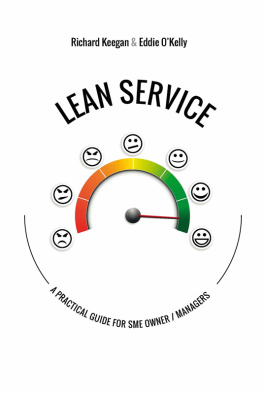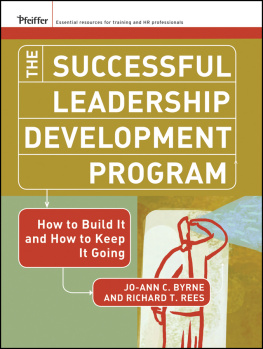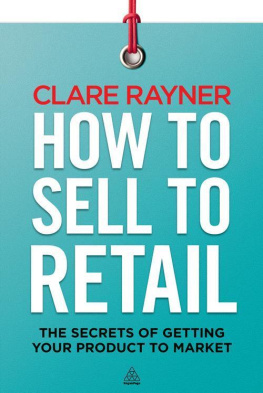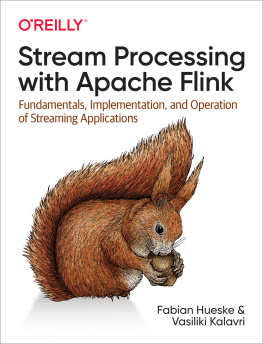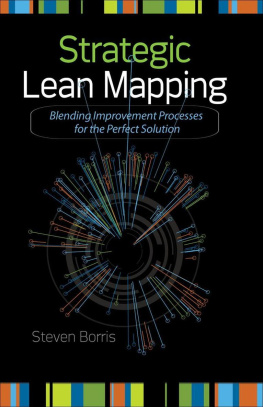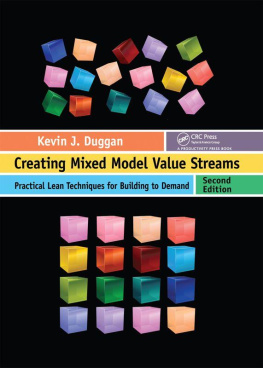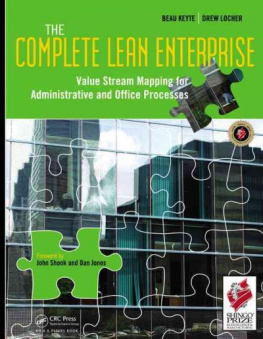Value Stream Management
In most organizations, no one person can describe the complete series of events required to transform a customer request into a good or serviceat least not with any level of detail around organizational performance. This gap in understanding is the kind of problem that leads to making improvements in one functional area only to create new problems in another area. Its the kind of problem that results in adding processes that increase operational cost but doesnt truly solve problems with root causes that reside upstream. Its the kind of problem that propels well-meaning companies to implement expensive technology solutions that do little to address the true problem or improve the customer experience.
The lack of understanding about how work flowsor, more commonly, doesnt flowacross a work system thats sole purpose is to deliver value to a customer is a fundamental problem that results in poor performance, poor business decisions, and poor work environments. Conflicting priorities, interdepartmental tension, andin the worst casesinfighting within leadership teams are common outcomes when a company attempts to operate without a clear understanding about how an organizations various parts fit together and how value is delivered to its customers. And significant time and money is wasted when organizations attempt to make improvement without a clearly defined, externally focused improvement strategy that places the customer in the center. Enter the concepts of value streams and value stream mapping.
WHAT IS A VALUE STREAM?
The term value stream was coined by James Womack, Daniel Jones, and Daniel Roos in the book that launched the Lean movement, The Machine that Changed the World (1990), and further popularized by James Womack and Daniel Jones in Lean Thinking (1996). A value stream is the sequence of activities an organization undertakes to deliver on a customer request. More broadly, a value stream is the sequence of activities required to design, produce, and deliver a good or service to a customer, and it includes the dual flows of information and material. Most value streams are highly cross-functional: the transformation of a customer request to a good or service flows through many functional departments or work teams within the organization.
An extended value stream includes those activities that precede a customer order (e.g., responding to a request for a quote, determining market needs, developing new products, etc.) or occur following the delivery of a good or service to a customer (e.g., billing and processing payments or submitting required compliance reports).
While many of a value streams activities occur sequentially, others may be performed concurrently (in parallel) to other work. The activities in a value stream are not merely those that an organization performs itself: work done by outside parties and even the customers themselves are part of a value stream.
Value streams come in many forms. The primary type of value stream is one in which a good or service is requested by and delivered to an external customer. Other value streams support the delivery of value; we often refer to these as value-enabling or support value streams. Examples of support value streams include recruiting, hiring, and onboarding; IT support; the annual budgeting process; and the sales cycle. Complex creative work can be viewed as having its own value streamfrom initial concept to an executable design or to product launch. Product design can be viewed as a value stream segment if the design is required to fulfill a specific customer order.
Many value streams can go on and on in both directions. For example, a value stream could include all of the activities from the time a customer selects an architect until drawings are delivered to a general contractor. Or until construction planning is complete. Or until the final inspection after a structure has been built. Or until revenue has been collected for the construction work. The product life cycle is also a value stream consisting of specification, design, supply chain, manufacture, commissioning, operation, and ultimately decommissioning and disposal. A full value stream for patient care might include appointment scheduling, registration, diagnosis, treatment, aftercare, and possibly even receipt of payment. As youll learn in , one of the first steps youll take in preparing to analyze a value stream is defining the scopethe fence posts or beginning and ending points for review. This will depend largely on the problems you need to address or the performance improvements you would like to realize.
So how many value streams does an organization have? It varies. Small organizations may have only one customer-facing value stream and many internal support value streams. Large organizations could have 5, 10, or even dozens of customer-facing value streams and hundreds of support value streams. Wherever there is a request and a deliverable, there is a value stream.
One way to determine how many value streams your organization has is by looking at the types of internal and external customer requests your organization receives and the number of variants of high-level process flows that each of those requests pass through. Requests that pass through similar process flow sequences form a single product family. To reap the greatest gains from viewing work and organizing the business according to value streams, you will eventually want to analyze and improve each product familys value stream. The best methodology weve found to date for this effort is value stream mapping, a tool that helps you visualize complex work systems so you can address the disconnects, redundancies, and gaps in how work gets done. Used properly, value stream mapping is far more than a design tool: its the most powerful organization transformation tool weve seen to date. Once people learn how to think in value stream terms, its difficult for them to look at work in any other way.
WHAT IS VALUE STREAM MAPPING?
The roots of value stream mapping can be traced to a visual mapping technique used at the Toyota Motor Corporation known as material and information flows. As the West grew intrigued with Toyotas consistent track record and began studying how Toyotas approach differed from its own, we learned that Toyotas focus on understanding the material and information flow across the organization was a significant contributor to its ability to perform at consistently high levels. As a result, mapping these types of flows became one of the hallmark approaches used in the Lean movement to transform operations. But value stream mapping is neither clearly understood nor effectively utilized in all circles. To understand why, a little history is in order.
Lean is a term that means different things to different people, which is one reason why companies, government agencies, and not-for-profit organizations have experienced such wide-ranging results from exploring and adopting Lean practices. When you look at the history of how Lean was introduced in the West and the degree to which our collective understanding of this management approach has evolved, you can see why theres confusion about what Lean is and what it is not.
The term Lean was coined by John Krafcik in a 1988 article based on his masters thesis at MIT Sloan School of Management and then popularized in The Machine that Changed the World and Lean Thinking. Lean Thinking summarized Womack and Joness findings from studying how Toyota operates, an approach that was spearheaded by Taiichi Ohno, codified by Shigeo Shingo, and strongly influenced by the work of W. Edwards Deming, Joseph Juran, Henry Ford, and U.S. grocery stores.



